Статьи журнала - International Journal of Image, Graphics and Signal Processing
Все статьи: 1056
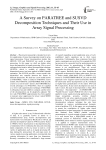
A Survey on PARATREE and SUSVD Decomposition Techniques and Their Use in Array Signal Processing
Статья научная
The present manuscript is intended to review few applications of tensor decomposition model in array signal processing. Tensor decomposition models like HOSVD, SVD and PARAFAC are useful in signal processing. In this paper we shall use higher order tensor decomposition in signal processing. Also, a novel orthogonal non-iterative tensor decomposition technique (SUSVD), which is scalable to arbitrary high dimensional tensor, has been applied in MIMO channel estimation. The SUSVD provides a tensor model with hierarchical tree structure between the factors in different dimensions. We shall use a new model known as PARATREE, which is related to PARAFAC tensor models. The PARAFAC and PARATREE both describe a tensor as a sum of rank-1 tensors, but PARATREE has several advantages over PARAFAC, when it is applied as a lower rank approximation technique. PARATREE is orthogonal, fast and reliable to compute, and the order of the decomposition can be adaptively adjusted. The low rank PARATREE approximation has been applied to measure noise suppression for tensor valued MIMO channel sounding measurements.
Бесплатно
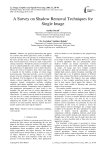
A Survey on Shadow Removal Techniques for Single Image
Статья научная
Shadows are physical phenomena that appear on a surface when direct light from a source is unable to reach the surface due to the presence of an object between the source and the surface. The formation of shadows and their various features has evolved as a topic of discussion among researchers. Though the presence of shadows can aid us in understanding the scene model, it might impair the performance of applications such as object detection. Hence, the removal of shadows from videos and images is required for the faultless working of certain image processing tasks. This paper presents a survey of notable shadow removal techniques for single image available in the literature. For the purpose of the survey, the various shadow removal algorithms are classified under five categories, namely, reintegration methods, relighting methods, patch-based methods, color transfer methods, and interactive methods. Comparative study of qualitative and quantitative performances of these works is also included. The pros and cons of various approaches are highlighted. The survey concludes with the following observations- (i) shadow removal should be performed in real time since it is usually considered as a preprocessing task, (ii) the texture and color information of the regions underlying the shadow must be recovered, (iii) there should be no hard transition between shadow and non-shadow regions after removing the shadows.
Бесплатно
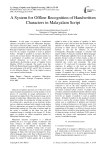
A System for Offline Recognition of Handwritten Characters in Malayalam Script
Статья научная
In this paper, we propose a handwritten character recognition system for Malayalam language. The feature extraction phase consists of gradient and curvature calculation and dimensionality reduction using Principal Component Analysis. Directional information from the arc tangent of gradient is used as gradient feature. Strength of gradient in curvature direction is used as the curvature feature. The proposed system uses a combination of gradient and curvature feature in reduced dimension as the feature vector. For classification, discriminative power of Support Vector Machine (SVM) is evaluated. The results reveal that SVM with Radial Basis Function (RBF) kernel yield the best performance with 96.28% and 97.96% of accuracy in two different datasets. This is the highest accuracy ever reported on these datasets.
Бесплатно
Статья научная
Encryption is used to prevent data from unauthorized access and with the appalling headway in network technology seen in the past decade; it has become the need of time to encrypt the images before sending over open network. Though researchers has proposed contrastive methods to encrypt images but correlation between pixels RGB value play a imperative part to guess for original image. So, here we introduce a new image encryption method which first rearranges the pixels within image on basis of RGB values and then forward intervening image for encryption. Experimentally it has shown that pixel rearrangement is enough from image encryption point of view but to send image over open network; inter-pixel displacement algorithm is applied to dispense more armament to image before transmission.
Бесплатно
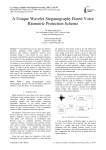
A Unique Wavelet Steganography Based Voice Biometric Protection Scheme
Статья научная
Voice biometric is an easy and cost effective biometric technique which requires minimalistic hardware and software complexity. General voice biometric needs a voice phrase by user which is processed with Mel Filter and Vector Quantized features are extracted. Vector quantization reduces the codebook size but decreases the accuracy of recognition. Therefore we propose a voice biometric system where voice file's non quantized code books are matched with spoken phrase. In order to ensure security to such direct voice sample we embed the voice file in a randomly selected image using DWT technique. Imposters are exposed to only images and are unaware of the voice files. We show that the technique produces better efficiency in comparison to VQ based technique.
Бесплатно
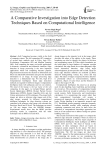
A comparative investigation into edge detection techniques based on computational intelligence
Статья научная
Soft Computing becomes visible in the field of computer science. The soft computing (SC) comprises of several basic methods such as Fuzzy logic (FL), Evolutionary Computation (EC) and Machine Learning (ML). Soft computing has many real-world applications in domestic, commercial and industrial situations. Edge detection in image processing is the most important applications where soft computing becomes popular. Edge detection decreases the measure of information and filters out undesirable information and gives the desirable information in an image. In image processing edge detection is a fundamental step. For this, high level Computational Intelligence based edge detections methods are required for different images. Computational Intelligence deals with ambiguous and low cost solution. The mind of the human is the key factor of the soft computing. In this paper, we included Binary particle Swarm Optimization (BPSO), Distinct Particle Swarm Optimization (DPSO), Genetic Algorithm (GA) and Ant Colony optimization (ACO) techniques. The ground truth images are taken as reference edge images and all the edge images acquired by different computational intelligent techniques for edge detection systems are contrasted with reference edge image with ascertain the Precision, Recall and F-Score. The techniques are tested on 100 test images from the BSD500 datasets. Experimental results show that the BPSO provides promising results in comparison with the other techniques such as DPSO, GA and ACO.
Бесплатно
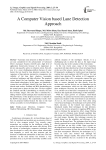
A computer vision based lane detection approach
Статья научная
Automatic lane detection to help the driver is an issue considered for the advancement of Advanced Driver Assistance Systems (ADAS) and a high level of application frameworks because of its importance in drivers and passerby safety in vehicular streets. But still, now it is a most challenging problem because of some factors that are faced by lane detection systems like as vagueness of lane patterns, perspective consequence, low visibility of the lane lines, shadows, incomplete occlusions, brightness and light reflection. The proposed system detects the lane boundary lines using computer vision-based technologies. In this paper, we introduced a system that can efficiently identify the lane lines on the smooth road surface. Gradient and HLS thresholding are the central part to detect the lane lines. We have applied the Gradient and HLS thresholding to identify the lane line in binary images. The color lane is estimated by a sliding window search technique that visualizes the lanes. The performance of the proposed system is evaluated on the KITTI road dataset. The experimental results show that our proposed method detects the lane on the road surface accurately in several brightness conditions.
Бесплатно
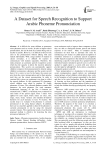
A dataset for speech recognition to support Arabic phoneme pronunciation
Статья научная
It is difficult for some children to pronounce some phonemes such as vowels. In order to improve their pronunciation, this can be done by a human being such as teacher or parents. However, it is difficult to discover the error in the pronunciation without talking with each student individually. With a large number of students in classes nowadays, it is difficult for teachers to communicate with students separately. Therefore, this study proposes an automatic speech recognition system which has the capacity to detect the incorrect phoneme pronunciation. This system can automatically support children to improve their pronunciation by directly asking children to pronounce a phoneme and the system can tell them if it is correct or not. In the future, the system can give them the correct pronunciation and let them practise until they get the correct pronunciation. In order to construct this system, an experiment was done to collect the speech database. In this experiment 89, elementary school children were asked to produce 28 Arabic phonemes 10 times. The collected database contains 890 utterances for each phoneme. For each utterance, fundamental frequency f0, the first 4 formants are extracted and 13 MFCC co-efficients were extracted for each frame of the speech signal. Then 7 statics were applied for each signal. These statics are (max, min, range, mean, mead, variance and standard divination) therefore for each utterance to have 91 features. The second step is to evaluate if the phoneme is correctly pronounced or not using human subjects. In addition, there are six classifiers applied to detect if the phoneme is correctly pronounced or not by using the extracted acoustic features. The experimental results reveal that the proposed method is effective for detecting the miss pronounced phoneme ("أ").
Бесплатно
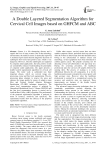
A double layered segmentation algorithm for cervical cell images based on GHFCM and ABC
Статья научная
Cancer is a life threatening disease and it engulfs the lives of many women. Due to the technology advancement, the medical science is drastically improved. A statistical report claims that the diagnostic decisions of radiologists show more false positive rates, which is very dangerous. However, when the radiologists are supported by computer aided applications, the false positive results are considerably reduced. Understanding the potentiality of computer aided applications, this paper presents a double layered segmentation algorithm for cervical cell images. The entire work is subdivided into three important phases, which are cervical image pre-processing, coarse and fine level segmentation. The pre-processing phase attempts to remove the noise and enhance the image quality by means of adaptive mean filter and Contrast Limited Adaptive Histogram Equalization (CLAHE) technique respectively. The coarse level segmentation process is achieved by Generalized Hierarchical Fuzzy C Means (GHFCM) and the fine level segmentation process is carried out by Artificial Bee Colony (ABC) algorithm. The performance of the proposed segmentation algorithm is analysed in terms of accuracy, sensitivity and specificity. The experimental results show the efficacy of the proposed segmentation algorithm.
Бесплатно
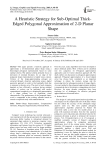
A heuristic strategy for sub-optimal thick-edged polygonal approximation of 2-D planar shape
Статья научная
This paper presents a heuristic approach to approximate a two-dimensional planar shape using a thick-edged polygonal representation based on some optimal criteria. The optimal criteria primarily focus on derivation of minimal thickness for an edge of the polygonal shape representation to handle noisy contour. Vertices of the shape-approximating polygon are extracted through a heuristic exploration using a digital geometric approach in order to find optimally thick-line to represent a discrete curve. The merit of such strategies depends on how efficiently a polygon having minimal number of vertices can be generated with modest computational complexity as a meaningful representation of a shape without loss of significant visual characteristics. The performance of the proposed frame- work is comparable to the existing schemes based on extensive empirical study with standard data set.
Бесплатно
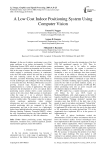
A low cost indoor positioning system using computer vision
Статья научная
In the era of robotics, positioning is one of the major problems in an indoor environment. A Global Positioning System (GPS), which is quite reliable system when it comes to outdoor environments and its accuracy falls in the range of meters. But for indoor environment, which requires a positioning accuracy in centimeters scale, the GPS cannot achieve this task due to its signal loss and scattering caused by the building walls. Therefore, an Indoor Positioning System (IPS) based on several technologies and techniques has been developed to overcome this issue. Nowadays, IPS becomes an active growing research topic because of its limitless implementations in a variety of applications. This paper represents the development of a low cost optical indoor positioning system solution where a static commercial camera is the only sensor. High accuracy in localization within the range of 1 cm is achieved. Detection, classification, and tracking techniques of an object are tested on mobile robots. The system is ideal for an indoor robotic warehouse application, where minimal infrastructure and cost parameters are required. The resulted positioning data are compared to the real measurement, and sent to the rovers via a lightweight broker-based publish/subscribe messaging protocol called Message Queuing Telemetry Transport (MQTT), where the only requirement between the client publisher and subscriber is the availability of a WLAN connection.
Бесплатно
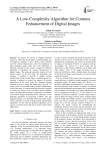
A low-complexity algorithm for contrast enhancement of digital images
Статья научная
As known, the contrast is a highly important feature by which the visual quality of digital images can be judged as adequate or poor. Hence, many methods exist for contrast enhancement, where the complexity of those methods usually varies due to the utilization of different concepts. In this article, a simple yet efficient algorithm is introduced for contrast enhancement of digital images. The proposed algorithm consists of four distinct stages: In the first stage, the hyperbolic sine function is applied to provide a simple contrast modification. In the second stage, a modified power-law function is utilized to control the amount of contrast adjustment. In the third stage, the standard sigmoid function is used to remap the image pixels into an “S” shape, which can provide further contrast enhancement. In the final stage, a contrast stretching function is applied to remap the image pixels into their natural dynamic range. The performed computer experiments on different low-contrast images demonstrated the efficiency of the proposed algorithm in processing synthetic and real degraded images, as it provided better and clearer results when compared to several existing contrast enhancement algorithms. To end with, the proposed algorithm can be used as a contrast processing step in many image-related applications.
Бесплатно
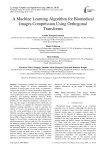
A machine learning algorithm for biomedical images compression using orthogonal transforms
Статья научная
Compression methods are increasingly used for medical images for efficient transmission and reduction of storage space. In this work, we proposed a compression scheme for colored biomedical image based on vector quantization and orthogonal transforms. The vector quantization relies on machine learning algorithm (K-Means and Splitting Method). Discrete Walsh Transform (DWaT) and Discrete Chebyshev Transform (DChT) are two orthogonal transforms considered. In a first step, the image is decomposed into sub-blocks, on each sub-block we applied the orthogonal transforms. Machine learning algorithm is used to calculate the centers of clusters and generates the codebook that is used for vector quantization on the transformed image. Huffman encoding is applied to the index resulting from the vector quantization. Parameters Such as Mean Square Error (MSE), Mean Average Error (MAE), PSNR (Peak Signal to Noise Ratio), compression ratio, compression and decompression time are analyzed. We observed that the proposed method achieves excellent performance in image quality with a reduction in storage space. Using the proposed method, we obtained a compression ratio greater than 99.50 percent. For some codebook size, we obtained a MSE and MAE equal to zero. A comparison between DWaT, DChT method and existing literature method is performed. The proposed method is really appropriate for biomedical images which cannot tolerate distortions of the reconstructed image because the slightest information on the image is important for diagnosis.
Бесплатно
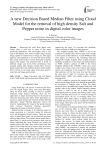
Статья научная
Removing the noise from digital color images plays a vital role in many of the image processing applications. Salt and Pepper noise is one type of the impulse noise which corrupts images during image capture or transmission or storage etc. This paper proposes and implements a new decision based median filter using cloud model to restore the highly corrupted digital color images. The proposed filter is tested on different images and shows better performance than standard median filter, adaptive median filter, decision based median filter and modified decision based median filter in terms of root mean square error, peak signal to noise ratio and image quality index.
Бесплатно
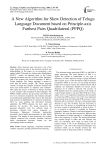
Статья научная
Skew detection and correction is one of the major preprocessing steps in the document analysis and understanding. In this paper we are proposing a new method called “Principle-axis farthest pairs Quadrilateral (PFPQ)” mainly for detecting skew in the Telugu language document and also in other Indian languages. One of the popular and classical languages of India is Telugu language. The Telugu language is spoken by more than 80 million people. The Telugu language consists of simple and complex characters attached with some extra marks known as “maatras” and “vatthulu”. This makes the process of skewing of Telugu document is more complex when compared to other languages. The PFPQ, initially performs pre-processing and divides the text in to connected components and estimates principle axis furthest pair quadrilateral then removes the small and large portions of quadrilaterals of connected components. Then by using painting and directional smearing algorithms the PFPQ estimates the skew angle and performs the de-skew. We tested extensively the proposed algorithm with five different kinds of documents collected from various categories i.e., Newspapers, Magazines, Textbooks, handwritten documents, Social media and documents of other Indian languages. The images of these documents also contain complex categories like scientific formulas, statistical tables, trigonometric functions, images, etc. and encouraging results are obtained.
Бесплатно
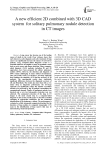
A new efficient 2D combined with 3D CAD system for solitary pulmonary nodule detection in CT images
Статья научная
Lung cancer has become one of the leading causes of death in the world. Clear evidence shows that early discovery, early diagnosis and early treatment of lung cancer can significantly increase the chance of survival for patients. Lung Computer-Aided Diagnosis (CAD) is a potential method to accomplish a range of quantitative tasks such as early cancer and disease detection. Many computer-aided diagnosis (CAD) methods, including 2D and 3D approaches, have been proposed for solitary pulmonary nodules (SPNs). However, the detection and diagnosis of SPNs remain challenging in many clinical circumstances. One goal of this work is to develop a two-stage approach that combines the simplicity of 2D and the accuracy of 3D methods. The experimental results show statistically significant differences between the diagnostic accuracy of 2D and 3Dmethods. The results also show that with a very minor drop in diagnostic performance the two-stage approach can significantly reduce the number of nodules needed to be processed by the 3D method, streamlining the computational demand. Finally, all malignant nodules were detected and a very low false-positive detection rate was achieved. The automated extraction of the lung in CT images is the most crucial step in a computer-aided diagnosis (CAD) system. In this paper we describe a method, consisting of appropriate techniques, for the automated identification of the pulmonary volume. The performance is evaluated as a fully automated computerized method for the detection of lung nodules in computed tomography (CT) scans in the identification of lung cancers that may be missed during visual interpretation.
Бесплатно
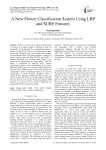
A new flower classification system using LBP and SURF features
Статья научная
Flowers are blessing of nature. Classification of flowers as a natural image is difficult as they are surrounded by background. So a segmentation phase is needed to separate the flower from background as good as possible. Computer vision has gained much attention for classification task. This paper proposes a method to classify flower with the help of LBP and SURF as features and SVM as a classifier. Input image is pre-processed for enhancement of image quality. Then the image is segmented by applying active contour segmentation method. After segmentation of the image, LBP and SURF features are extracted. SURF features are extracted from MSER regions. Then both features are concatenated. These concatenated features are sent for classification to SVM classifier. Quadratic SVM is employed here. Quadratic SVM trains these feature and tests to classify. We also tried out with different classifier. But they provide poor results. Proposed quadratic SVM achieves an accuracy of 87.2% which is significant and comparable for this classification taskK.
Бесплатно
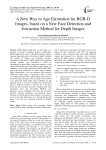
Статья научная
With adding depth data to color data, it is possible to increase recognition accuracy significantly. Depth image mostly uses for calculating range or distance between object and sensor. Also they are used for making 3-D models of objects and increasing accuracy. Depending on the sensor’s depth quality, the recognition accuracy changes. Age estimation is useful for calculating the aging effects using prior patterns, which are recorded during years from subjects. In this paper, age estimation occurs using summation of RGB image edges gray value and summation of depth image’s entropy edges. Furthermore, a new face detection and extraction method for depth images is represented, which is based on standard deviation filter, ellipse fitting and some pre-post processing techniques. The advantage of this method is its speed and single image aspect capability. In this approach, there is no need to learning and classification process. Proposed method is between 10 to 20 times faster but lower accurate. System is validated with some benchmark color and color-depth (RGB-D) face databases, and in comparing with other age estimation methods, returned satisfactory and promising results. Because of the high speed in this method, it is possible to use it on real time applications. It is mentionable that this paper is the first age estimation research on RGB-D images.
Бесплатно
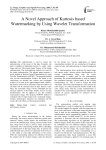
A novel approach of kurtosis based watermarking by using wavelet transformation
Статья научная
The authentication is used to ensure the authentication of the owner of the data. Currently, the data is available in multimedia format viz., audio, video, image and text. The present paper focuses on the image authentication. The watermarking methods are used for the image authentication. The present paper proposes a novel method of Kurtosis based Watermarking by using Wavelet Transformation (KWWT). The proposed method uses wavelet transformation. Further, the bands or the coefficients are divided into various non overlapped windows. For each of the approximation band windows, the kurtosis value will be estimated. Then the windows in all bands will be selected based on their kurtosis value. Then, the watermark image will be embedded into the selected windows of the bands. Finally, inverse wavelet transformation will be applied to get the resultant watermarked image. The proposed KWWT method is evaluated with 14 input images and 3 watermark images. Various performance measures are estimated and the results show the efficacy of the proposed method.
Бесплатно
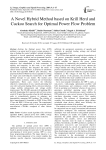
A novel hybrid method based on krill herd and cuckoo search for optimal power flow problem
Статья научная
Solving the Optimal power flow (OPF) problem is an urgent task for power system operators. It aims at finding the control variables’ optimal scheduling subjected to several operational constraints to achieve certain economic, technical and environmental benefits. The OPF problem is mathematically expressed as a nonlinear optimization problem with contradictory objectives and subordinated to both constraints of equality and inequality. In this work, a new hybrid optimization technique, that integrates the merits of cuckoo search (CS) optimizer, is proposed to ameliorate the krill herd algorithm (KHA)'s poor efficiency. The proposed hybrid CS-KHA has been expanded for solving for single and multi-objective frameworks of the OPF problem through 11 case studies. The studied cases reflect various economic, technical and environmental requirements. These cases involve the following objectives: minimization of non- smooth generating fuel cost with valve-point loading effects, emission reduction, voltage stability enhancement and voltage profile improvement. The CS-KHA presents krill updating (KU) and krill abandoning (KA) operator derived from cuckoo search (CS) amid the procedure when the krill updating in order to extraordinarily improve its adequacy and dependability managing OPF problem. The viability of these improvements is examined on IEEE 30-bus, IEEE 57-bus and IEEE 118-bus test system. The experimental results prove the greatest ability of the proposed hybrid meta-heuristic CS-KHA compared to other famous methods.
Бесплатно

